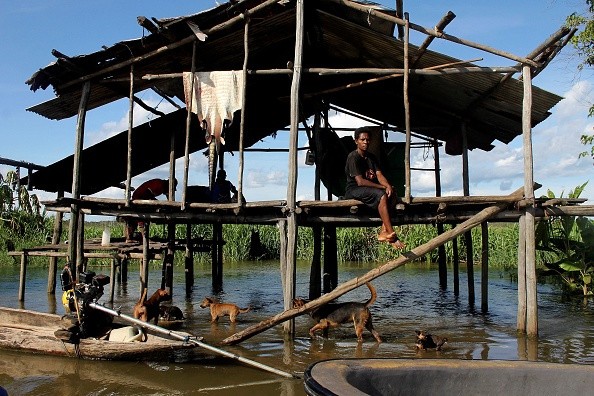The kuru epidemic almost wiped out the Indigenous Fore people of Papua New Guinea in the 1950s and 1960s.

Origins of the Kuru Disease
Outsiders had no idea the Fore people of Papua New Guinea existed until the 1930s. The Fore had lived in isolation for years in a remote part of the planet, creating a unique culture and customs that were unknown to their fellow islanders. Ritual cannibalism was one among these practices, and it resulted in an illness known as kuru, which spread widely, as per All Thats Interesting.
In the eastern highlands of Papua New Guinea, Australian gold prospectors were the first foreigners to come into touch with the indigenous inhabitants. As soon as the gold prospectors arrived, researchers and police officers quickly followed. After 20 years, the Fore's cannibalism and its tragic effects would finally come to light.
This disease was transmitted by the Fore's insatiable appetite for corpses. Also called the "laughing death," this lethal brain illness renders sufferers incapable of controlling their emotions, limbs, and other physiological processes. Tragically, many people who get the condition have uncontrolled fits of giggles and die within one year after first displaying symptoms.
There were two-percent deaths every year in the 1950s because to kuru. However, although Fore and outside experts were aware of a huge issue, they had no understanding what was causing the laughing dying pandemic at that time. It wasn't long before everyone realized what was really happening.
It is well-known that Papua New Guinea is home to a large number of Indigenous peoples who have been unspoiled by outside civilization for a long time. These people established a unique spectrum of customs and rituals in their houses buried within the deep woods blanketing the country's highlands.
Until the 16th century, Portuguese and Spanish explorers had never set foot in the area. Even then, they only spoke with those who lived around the shores of the planet. As a result, many indigenous peoples remained isolated from the rest of the world until far into the twentieth century.
Cannibalism was practiced by some of the more distant societies, such as the Fore. The Fore strongly thought that the ceremony was a holy funeral rite, regardless of how other tribes viewed it.
As a result, when a loved one died, the family would boil the corpse and consume it. By performing this ceremony, the Fore people hoped to control the spirit of the departed and pay tribute to the deceased.
Ritual Cannibalism: The Cause of Laughing Death Epidemic
Because their bodies were supposed to be capable of containing a "dangerous" soul, males were seldom given the responsibility of eating a person's corpse. Almost every organ and bit of "flesh" except the gallbladder would be consumed by them.
The brain was an important part of this. However, moms would occasionally give their young children "snacks" from the corpses. So, kuru mostly afflicted women and children.
Despite the fact that missionaries and colonial authorities opposed the practice, cannibalism persisted among certain Fore tribes. Researchers don't know precisely when the kuru sickness initially occurred in this group.
Others say it began in the 1910s or 1920s, far before they came into touch with foreigners and were exposed to outside influences.
It's a reasonable assumption, given the disease's absence from Fore histories and the Fore's own admission that it was reducing their numbers. Fore would have vanished if they had continued to coexist with kuru for many more generations.
When Australian and American researchers first saw them in the 1950s, there were still up to 11,000 of them.
Researchers and the Fore were at a loss as to what kuru really was or how it propagated. The laughing death had spread into an epidemic, killing up to 200 individuals a year, and they were well aware of this.
Researchers speculated that the sickness was caused by pollutants or heredity, while the Fore people believed it was caused by males engaging in "sorcery." That was until the early 1960s when scientists finally figured out what had been going on.

The End of the Kuru Epidemic
A pioneering study of kuru in 1961 included anthropologist Shirley Lindenbaum and her then-husband Robert Glasse. They investigated probable causes of the sickness by traveling from village to village in the Fore community.
Human brain samples infected with the virus were injected into chimpanzees by the researchers. Lindenbaum's notion was confirmed when the chimpanzees started to show indications of kuru months later.
Nobel Prizes were awarded to the researchers who conducted the chimpanzee experiment. Understanding disorders like Creutzfeldt-Jakob disease, bovine spongiform encephalopathy (or "mad cow disease"), and neurodegenerative diseases like Alzheimer's was aided by the study findings.
Even while the Fore's practice of cannibalism led to tragedy, experts discovered that it also led to a unique adaptability. A gene that protects some Fore from kuru and other prion diseases, such as mad cow, was discovered by scientists in 2015.
While the Fore of today are unlikely to return to the gruesome practices of their ancestors, they can be grateful that an unintended consequence of a long-held ritual now offers a positive trait that may hold the key to defeating some of humanity's most debilitating neurological conditions..
Related Article : Watch Out! Brain-Eating Amoeba That Killed 11-Year-Old Girl Found Lurking in U.S. National Park
For more news, updates about brain diseases and similar topics don't forget to follow Nature World News!
© 2025 NatureWorldNews.com All rights reserved. Do not reproduce without permission.





